Cuisine of Abruzzo
 |
| Italian cuisine |
|---|
|
|
The Abruzzo cuisine is the traditional cuisine of Abruzzo; it is very wide and is originally from the traditions of both pastoral and mountainous inland areas that marinate in the coastal zone; among the foods most commonly used are: bread, pasta, meat, cheese and wine. The isolation that has characterized the region for decades has ensured that it maintained a culinary art alive and independent.[1] Abruzzo boasts a cuisine distinct within Italy, well known for its variety and richness owing to the heterogeneity of its territory. The mountainous, agricultural, and coastal aspects of Abruzzo have contributed to its cuisine. Due to the mountains themselves, much of Abruzzese cuisine grew separated from the influence of international commerce and civilization until the 20th century, fostering a unique culinary tradition.[2] In 2013, the Italian organization Confesercenti led a research which indicated Abruzzo as the best region where to eat in Italy according to foreign tourists ratings.[3][4]
Due to the long history of shepherding and strong traditional shepherd culture in Abruzzo, lamb and mutton dishes are heavily associated with Abruzzese cuisine and are common in most provinces of Abruzzo, although these lamb and sheep dishes are mainly found in the mountainous areas of Abruzzo and are less common on the coastal plains.[5] Lamb and sheep are also an important source of Abruzzese cheese, such as sheep's milk ricotta, and lamb intestines are often used as sausage casing or for stuffed meat rolls.[5][6] Mountain goat meat is also common in Abruzzo. Other prominent ingredients and dishes in Abruzzese cuisine include truffles and mushrooms, often wild mushrooms from the forests and hills of Abruzzo; garlic, especially local red garlic; extra virgin olive oil; and rosemary. Hot chili pepper or peperoncini, regionally known as diavolilli or diavoletti, is ubiquitous in much of Abruzzese cuisine and often used to add spice to dishes, while saffron is a speciality spice specifically of L'Aquila.[6][7][8][9] In addition to mushrooms, Abruzzese cuisine commonly employs "rustic" or "peasant" vegetation such as lentils, grasspeas and other legumes, artichoke, eggplant, and cauliflower.[5][6][8][10] Famous Abruzzese dishes include arrosticini, maccheroni alla chitarra, and scrippelle.[5][6]
Products
Among the products and dishes of Abruzzo that have entered the collective imagination of the world or become diffused in different parts of the world are:
- The classic dragée[11] (confetti) typical of the city of Sulmona
- The saffron[12] cultivated mainly in Navelli
- Renowned wines like Montepulciano DOCG and Trebbiano d'Abruzzo DOC are considered amongst the world’s finest wines.[13] In 2012 a bottle of Trebbiano d'Abruzzo ranked #1 in the top 50 Italian wine award[14][15]
- Best-known is the extra-virgin olive oil produced in Colline Teramane (Teramo hills), marked by the quality level DOP and considered one of the best in the country.[16]
- Abruzzo's liquorice: Abruzzo is the lead region of Italy for the production of this product along with Calabria[17][18]
- Pizzelle cookies from Abruzzo are well known in the Northeastern United States as a Christmas cookie, especially among Italian Americans and in cities such as Philadelphia where Abruzzese immigrants settled in large numbers.[19][20]
- Porchetta, although of general Central Italian origin, was brought by Abruzzese immigrants to the Northeastern United States, especially Philadelphia, where it is known as "Italian roast pork" or simply "roast pork."[21][22][23]
Dishes
Starters
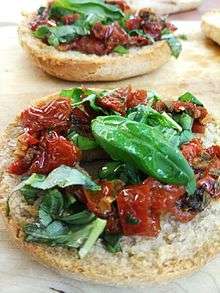
The starters (called antipasti) include:
- Bruschetta, classic bruschetta smeared with, salt and oil, sausage or some vegetables like tomato or zucchini with mozzarella
- Antipasto di fegatini, typical appetizer of meat of the culinary tradition of Teramo, consists of: chicken livers, onion, peppers, vinegar, sugar, dry wine, pepper, salt, oil
- Mussels of Vasto: mussels stuffed with a mixture of breadcrumbs, garlic and parsley, olive oil, a few drops of lemon juice and a little tomato sauce.
- Mussels with saffron: classic steamed mussels prepared with parsley, onion, bay leaf, white wine, olive oil and seasoned with saffron sauce.
- Stockfish or salt cod: cod cooked in a pan with potatoes, tomatoes, oil, garlic, parsley, onion, red pepper, salt and black olives.
- Sauce all'aquilana: mix of beef marrow with saffron in Abruzzo, eggs, cream, butter.
Pasta
One of the most prominent dishes of the region is maccheroni alla chitarra. This dish is created by pressing or cutting pasta through an instrument called a chitarra, creating long thin noodles similar to spaghetti. The pasta is served with a tomato-based sauce, often flavored with peppers, pork, goose, or lamb.[24]
This dish is served with complementary regional side dishes, such as the bean and noodle soup known as sagne e fagioli. This soup is traditionally flavored with tomatoes, garlic, oil, and peperoncini.[25]
Other popular dishes include:
- Gnocchi carrati, flavored with bacon, eggs and pecorino cheese
- Scrippelle, a rustic pancake-like dish from Teramo, similar to a French-style crêpe, served either mbusse (in broth as a type of soup) or used to form a sort of soufflé with some ragù and stuffed with chicken liver, meatballs, hard-boiled eggs, and cheese[25][26]
- Pastuccia, a polenta stew with sausage, eggs, and cheese
Main dish
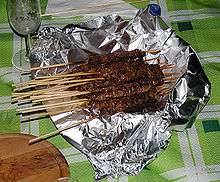
Across the region, roast lamb is enjoyed in several variations. Some of these variations include:
- Arrosticini, a skewered sheep dish.[27][25]
- Pecora al cotturo, sheep stuffed with a variety of mountain herbs and cooked in a copper pot
- Lamb cooked whole in a bread oven
- Agnello cacio e ovo, a lamb-based fricassee
Other main dishes usually containing meat include:
- Mazzerella, lamb intestines filled with lamb, garlic, marjoram, lettuce, and various spices. Specialty of Teramo.
- Le Virtù, a heavy soup from Teramo made with legumes, vegetables and pork meat, usually eaten in the spring as a celebratory dish.
- Timballo abruzzese, large baked lasagna-like dish, containing pasta sheets or scrippelle sheets filled with meat, vegetables and/or rice, often served for Christmas and Easter. A specialty of Teramo.[25]
- Porchetta abruzzese, a moist boneless pork roast, slow roasted with rosemary, garlic, and pepper.[25]
Seafood also plays a role in the cuisine of Abruzzo, especially in those areas located closer to the coast. The variety of fish available to the area has resulted in several fish-based Brodetti (broths), coming from such places as Vasto, Giulianova, and Pescara. These broths are often created by cooking the fish in an earthenware pot, and flavored with tomatoes, herbs, and peperoncino. Others seafood include the Scapece of Vasto (Fish marinade); is the only dish in Abruzzi to use saffron, although this spice is one of the most important regional products. It is a fish marinade (often skate) cut into pieces, floured and browned in a frying pan. Thanks to vinegar the dish can keep for 20 to 30 days in special wood containers handed down from generation to generation.[28]
Breads and Pizzas
- Pane di mais (Corn bread), many argue that in the past this was a stopgap, a poor alternative to bread wheat flour, while others argue for its use on special occasions. Today its consumption is linked to everyday choices, perhaps to particular combinations. In Abruzzo, the prevalent forms are the loaf and the loaf oval. One of the variants of this bread, linked to Easter traditions, it is adding to the classic boiled potatoes, olive oil, eggs and milk.
- Bread of Senator Cappelli, present mainly in the province of Chieti. The name comes from the variety of wheat flour with which it is produced. The crops of wheat Senator Cappelli remained in vogue until the '60s, when they were partially replaced by more productive cultivars. The quality of this product has recently been rediscovered, and preferred forms of this type of bread is the strand the round and elongated.
- Bread ear, The flour is used for bread ear of wheat, and the name is due precisely to the fact that in its upper part are practiced before baking small cuts that resemble the ear of wheat.
Rustic pizzas are also very common. Some of these are:
- Easter Pizza (Pizza di Pasqua), a rustic cake with cheese and pepper from the Teramo area
- Pizza fritta, shallow-fried pizza.[25]
- Fiadoni from Chieti, dough of eggs and cheese well risen, cooked in the oven in a thin casing of pastry
- A rustic tart pastry filled with everything imaginable: eggs, fresh cheeses, ricotta, vegetables, and all sorts of flavorings and spices
Charcuterie
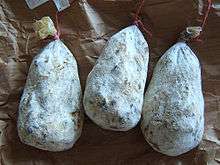
Also from Teramo are the spreadable sausages flavored with nutmeg, liver sausages tasting of garlic and spices. The ventricina from the Vasto area is made with large pieces of fat and lean pork, pressed and seasoned with powdered sweet peppers and fennel and all encased in the dehydrated stomach of the pig itself. Mortadella di Campotosto is another product famous in Abruzzo; is a small mortadella, longish oval-shape. Inside, it is dark red, with a white column of fat. They are generally sold two tied together. Together, they are about as big as two cupped hands put together. Another name for the mortadella in Italian is "coglioni di mulo" (donkey's balls.); using meat from the shoulder and loin and trimmings from making prosciutto, mixed with fat. In all, it is 80% lean meat, of which 25% will be prosciutto (ham), and 20% pancetta. The meat is finely minced, and mixed with seasonings (salt, pepper, white wine.) Some makers will also use cinnamon and cloves and no nitrates are used.
Cheeses
The principal cheeses of region are:
- White cow cheese, is a soft cheese made from cow's milk, produced throughout the region Abruzzo
- Caciocavallo abruzzese, It is a dairy product with compact paste and soft, the typical structure of thin leaves and homogeneous, free from holes and slightly elastic, made from raw whole cow's milk with rennet and salt
- Caciofiore Aquilano, The ingredients are whole milk raw sheep of the most popular breeds, as well as rennet artichoke and saffron, which give it its characteristic yellow color. The cheese is ready for consumption, which has a delicate aroma of milk and a subtle flavor and very fine
- Caciotta vaccination frentana, It is a half-cooked cheese semi-hard cheese made from cow's milk. Derives from the processing of raw whole cow's milk, with the addition of rennet and salt
- Canestrato of Castel del Monte, It is a hard cheese made from raw whole milk of sheep, with the addition of rennet and salt
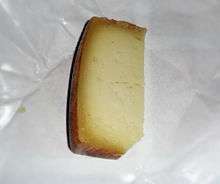
- Caprino abruzzese, the ingredients are raw whole milk goat (possibly to make it more consistent you add a small percentage of sheep's milk), curd (only for the cheese rennet coagulation), salt
- Cheese and curd stazzo, cheese and by-products obtained from the processing of raw milk from sheep, cattle and goats
- Junket vaccination or the Abruzzo sprisciocca, is a soft fresh cheese made from cow's milk. Ingredients are raw whole cow's milk, rennet, salt
- Pecorino d'Abruzzo, the cheese is one of the flagship products of Abruzzo and is a semi-hard or hard cheese, dry and mild with holes, which is derived from raw whole milk of sheep with the addition of rennet of animal origin (preferably sheep or goat) and salt
- Pecorino di Atri , is a cheese with a compact, semi-cooked, made from sheep's milk with rennet of animal origin (preferably sheep or goat) and salt
- Pecorino di Farindola, cheese with compact paste, semi-friable and made from sheep milk added with pork rennet
- Ricotta, It is obtained by treating the serum exhausted, which remains after the coagulation of raw whole milk of sheep and that is heated after being filtered
- Scamorza d'Abruzzo, It is a stretched curd cheese made from cow's milk, which can be eaten fresh or wilted. It is made from raw whole cow's milk, rennet (which can be in liquid or powder) and salt
Atri and Rivisondoli also are famous for cheeses. Mozzarella, either fresh or seasoned, made from ewe's milk, although a great number of lesser known varieties of these cheeses can be found all over Abruzzo and Molise.
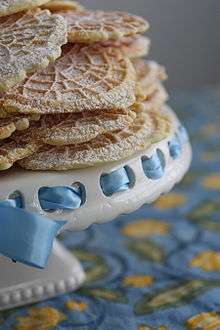
Desserts and sweets
The sweets of Abruzzo are famous throughout the world. Some of the better known include:
- Confetti, sugar-coated almonds, from Sulmona
- Torrone Nurzia, a chocolate nougat from L'Aquila
- Parrozzo , a cake-like treat made from a mixture of crushed almonds, and coated in chocolate
- Pizzelle (also known as Ferratelle). A waffle cookie, often flavored with anise.[25]
- Croccante, a type of nougat made from almonds and caramelized sugar, often flavored with lemon[29]
- Calgionetti, Cagionetti, Caggiunitti, caviciunette, swli style of Christmas fritters, sometimes filled with chestnuts and sometimes with chickpeas; flavored with chocolate or cocoa (for a recipe see Italy Revisited/Calcioni)
- Bocconotto, Bocconotti, stuffed sweets often served for Christmas
- Zeppole di San Giuseppe, pastries, sometimes fried, sometimes baked, made for the Feast Day of St. Joseph
Fruits
The principal fruits of Abruzzo are:
- Agrumi della costa dei trabocchi, citrus of the coast, especially oranges, either use for the production of jams, and lemon juice used for their excellent or for the production of the famous Limoncello.
- Castagna roscetta della Valle Roveto, a type of chestnut
- Ciliege di Raiano e di Giuliano Teatino, local type of cherry
- Mandorle di Navelli, almond of small town of Navelli
- Marrone di Valle Castellana, other type of chestnut
- Mela della Valle Giovenco, typical apples of Abruzzo region
- Uva di Tollo e Ortona, table grapes are also used for the production of jam
Wines and drinks
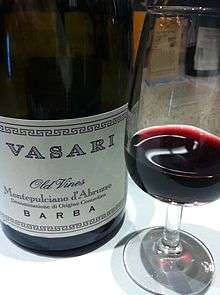
The principal wines of region are:
- Montepulciano d'Abruzzo, renowned and famous wine red considered one of the world’s finest wine.
- Cerasuolo d'Abruzzo, other famous wine of region.
- Trebbiano d'Abruzzo, the wine white of Abruzzo region.
Others wines are:
- Montonico
- Pecorino
- Passerina
- Controguerra
The drinks include:
- Genziana, a liqueur made from gentian root, an excellent digestive typical of Abruzzo
- Centerba, aromatic liqueur typical of Abruzzo obtained by the infusion of herbs and medicinal mountain by high degrees
- Aurum, liquor with an alcohol content of 40 °, based on brandy and infused with oranges. It is a specialty of Pescara city
- Ratafià, liqueur composed of black cherry liqueur and wine manly Montepulciano d'Abruzzo.
- Liquorice drink, liqueur composed with liquorice of Abruzzo mountains
See also
- Italian cuisine
-
 Italy portal
Italy portal -
 Food portal
Food portal
References
- ↑ History of Italian Cuisine - Restaurants Abruzzo - the Kitchen <! - Title automatically generated ->
- ↑ http://www.mariobatali.com/abruzzo/
- ↑ http://www.bompensaoliveoil.com/e-labruzzo-la-regione-dove-si-mangia-meglio/
- ↑ http://tantowines.com/category/food
- 1 2 3 4 Rosengarten, David. "The Cuisine of Abruzzo: Easy to Love, Not So Easy to Describe". Huffington Post. Retrieved 6 January 2016.
- 1 2 3 4 "ABRUZZO IN TAVOLA". Academia Barilla. Retrieved 6 January 2016.
- ↑ Levinson, Debra (2012). Italy Luxury Family Hotels and Resorts. Max Publication, Incorporated. Retrieved 6 January 2016.
- 1 2 Braimbridge, Sophie (2005). Food of Italy. Allen & Unwin. Retrieved 6 January 2016.
- ↑ "Abruzzo, Italy". Delallo. Retrieved 6 January 2016.
- ↑ Nicoletti, Amy. "Wild Mushrooms in Italy - Kitchen Tips & Recipe Ideas". Delallo. Retrieved 6 January 2016.
- ↑ Abruzzo Tourism Promotion - Know <! - Title automatically generated ->
- ↑ Abruzzo Tourism Promotion - Know <! - Title automatically generated ->
- ↑ http://www.winecountry.it/regions/
- ↑ "Archived copy". Archived from the original on 2014-11-10. Retrieved 2014-11-10.
- ↑ Abruzzo Tourism Promotion - Know <! - Title automatically generated ->
- ↑ "Archived copy". Archived from the original on 2011-01-12. Retrieved 2016-08-15.
- ↑ http://www.lifeinabruzzo.com/liquorice-all-sorts-in-abruzzo/
- ↑ http://www.ashbytreats.com/gourmet-liquorice
- ↑ Pro, Johnna A. (December 4, 2003). "Immigrant's success was struck when pizzelle iron was hot". Pittsburgh Post-Gazette. Retrieved 6 January 2016.
- ↑ "Pizzelle Partyin' like it's 1392". Philadelphia City Paper. 2010-12-17. Retrieved 6 January 2016.
- ↑ Hollman, Laurie (November 26, 1992). "Going Whole Hog This Holiday Think Carving A Bird Is Hard? Try This Italian Treat.". Philadelphia Inquirer. Retrieved 6 January 2016.
- ↑ Evans Sorid, Barbara (November 25, 1990). "Medford Market's Old World-style Roast Pork A Hit". Philadelphia Inquirer. Retrieved 6 January 2016.
- ↑ Wilson, Bee (Oct 15, 2010). Sandwich: A Global History. Reaktion Books. Retrieved 6 January 2016.
- ↑ Abruzzo Tourism Promotion - Know <! - Title automatically generated ->
- 1 2 3 4 5 6 7 Di Gregorio, Luciano (2013). Bradt Abruzzo. Bradt Travel Guides. Retrieved 6 January 2016.
- ↑ http://www.gditaly.com/italy/abruzzo/typical_products/scrippelle.htm
- ↑ Abruzzo Tourism Promotion - Know <! - Title automatically generated ->
- ↑ http://www.gditaly.com/italy/abruzzo/typical_products/scapece.htm
- ↑ "Abruzzo and Molise Heritage Society". Abruzzomoliseheritagesociety.org. Archived from the original on 2013-03-09. Retrieved 2013-03-12.